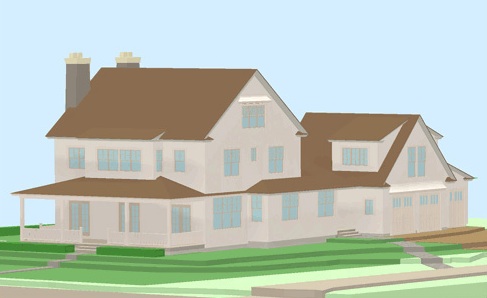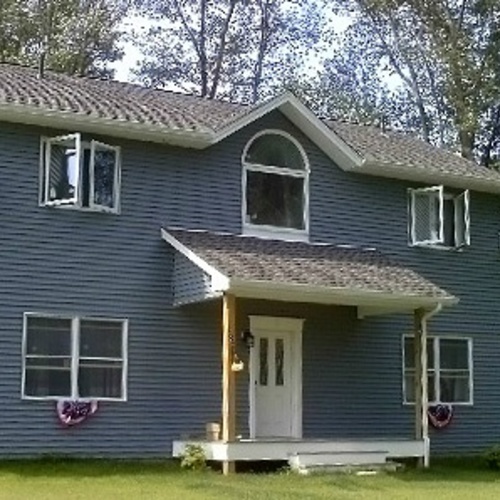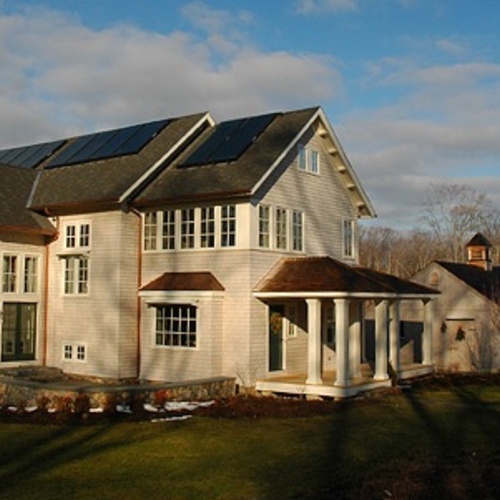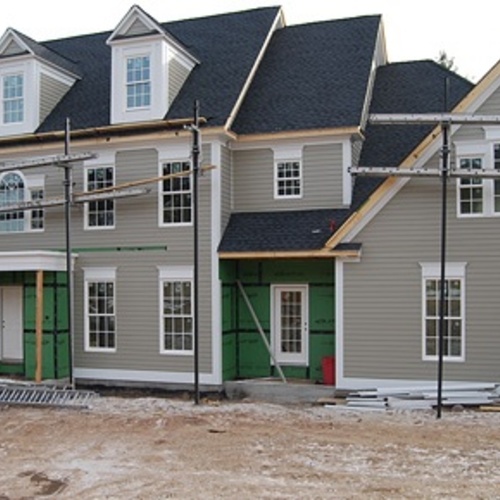
Image Credit: Campaigne Kestner Architects (images 1, 2, and 3); BPC Green Builders (image 4); Green Planet Options (images 5 and 6); Ark Contractors (images 7 and 8); Crosskey Architects (image 9)
Image Credit: Campaigne Kestner Architects (images 1, 2, and 3); BPC Green Builders (image 4); Green Planet Options (images 5 and 6); Ark Contractors (images 7 and 8); Crosskey Architects (image 9) The home that previously occupied the Madison site. The new foundation of the home being built in Madison. One of BPC Green Builders’ two Challenge entrants, a 4,944 sq. ft. home being built in New Canaan. Green Planet Options’ affordable-housing project in Guilford. Some of the energy efficiency and renewable-energy components of Green Planet Options’ project in Guilford. Ark Contractor’s 2,800 sq. ft. three-bedroom home, the Greenbriar, in Oakdale. A portion of the Greenbriar’s HVAC setup, including its gas furnace. One of Crosskey Architects’ affordable-housing duplexes, which are being built in Hartford. Each duplex unit is 1,576 sq. ft.
Since we last mentioned the Connecticut Zero Energy Challenge, back in July, many of its 18 entries have progressed significantly, including one beach-area build in Madison, with a view of the Long Island Sound, that recently attracted the attention of the New Haven Register, and several other far more modest (but just as interesting) projects elsewhere in the state.
The Challenge, which officially launched in May 2009, is scheduled to end December 1, when the operating performance of each home will be evaluated using the Residential Energy Services Network’s HERS Index. The results will be announced on December 8. The three lowest HERS ratings win prize money: $15,000 for first place, $10,000 for second, $5,000 for third. But virtually all participants get at least some free publicity.
The project in Madison is one of the bigger homes on the Challenge list, a six-bedroom with 4,300 sq. ft. aboveground and, in the basement, another 330 sq. ft. of conditioned space. Its owners, who live nearby, intend to use the house to accommodate family and other visitors during the warm months. It is, obviously, about double the size of homes that fit the ideal green-home profile, although the design and systems configurations for this particular house will allow sections of it to be shut down in the off-season, reducing the conditioned space to 3,000 sq. ft.
Russell Campaigne, of Campaigne Kestner Architects, says the project’s 2×6 framing will be filled with Demilec Agribalance spray foam insulation; a 2-in. layer of expanded polystyrene foam will be used to create a contiguous envelope, and OSB sheathing will cover the exterior insulation. The exterior-wall system is expected to deliver R-30 thermal resistance, on average, while the roof system is designed to provide R-45. The building will also be equipped with orientation-specific glazing, overhangs, 9.6 kW of photovoltaics, solar hot water, and a zoned ground-source heat pump.
The other big homes
The home in Madison is big, but not the largest home in the running. That distinction belongs to a 4,944 sq. ft. home being built in New Canaan by BPC Green Builders (which also is building a 3,700 sq. ft. home in Ridgefield that is among the contestants). Three other projects in the contest lineup are over 4,000 sq. ft. – a four-bedroom house in South New Milford, at 4,600 sq. ft.; a 4,400 sq. ft. five-bedroom home in Fairfield; and a 4,363 sq. ft. five-bedroom in Avon.
Two affordable-housing contenders
Another of the entries, a nine-unit group of homes being built for the Guilford Housing Authority by Norwalk-based Green Planet Options, is moving along within the financial constraints of affordable housing. Built in clusters of three, these homes will each offer 600 sq. ft. of conditioned space. The developer says the units will be built on R-24 insulated concrete forms that also feature perimeter sub-slab insulation. Exterior walls will be insulated to R-38 and ceilings to R-57. Each roof will be covered with light-reflecting, standing-seam metal and, if all goes as planned, will be equipped with a 2.76-kW photovoltaic array.
The project will be seeking LEED certification and will incorporate additional green and sustainable materials and methods throughout, Green Planet says, adding that the Guilford Housing Authority wants the new housing to serve as an example of small, well designed, energy efficient, affordable housing.
Another Challenge project underway on a modest budget is a set of three duplexes in Hartford, each offering two three-bedroom units of 1,576 sq. ft. Leading the way is Crosskey Architects, which is presenting the project as an affordable, energy efficient prototype for SAND Corporation, one of Connecticut’s oldest nonprofit developers.
Crosskey, in collaboration with Acorn Consulting Engineers, has designed the units to operate 67% more efficiently than comparable units built to code. Like their Challenge competitors, these homes will rely on a combination of energy efficient construction, HVAC refinements, and renewable-energy sources, including, for this particular project, ground-source heat pumps, heat-recovery ventilators, solar hot water, and thorough insulation and air sealing.
Energy efficiency in Oakdale
Aiming more at the middle of the market, Challenge contestant Ark Contractors has entered its 2,800 sq. ft. three-bedroom home in Oakdale, in southeastern Connecticut. Called the Greenbriar, the home features R-10 insulation under the slab, R-20 basement walls, R-40 exterior walls, and an R-60 roof. Builder James Pepitone notes that much of the insulation was attached outside of the frame to reduce thermal bridging and moisture buildup in the wall cavity. The exterior-wall system includes 3 in. of foil-faced and sealed polyisocyanurate, with a 1-in. air chamber between the siding and the insulation.
The centerpiece of the HVAC system for this house is a hybrid air-source heat pump that generates heat at outdoor temperatures down to 40°F; below that, a gas-fired furnace kicks in to supplement the heat pump. Like all of the other Challenge entries, this house will be equipped with a PV system – a 10-kW installation, in this case.
Weekly Newsletter
Get building science and energy efficiency advice, plus special offers, in your inbox.















2 Comments
Why EPS?
I'm confused as to why Campaigne Kestner Architects is specifying EPS foam on the exterior instead of XPS. XPS is a proven product with great R-value and can be used as a drainage plane with installed per the manufacturers instructions.
EPS Foam
You are right we used EPS (expanded polystyrene) foam and not EXP (Extruded polystyrene) In the energy modeling of the project we tested both as well as isocyanuate. The ESP has a slightly lower r-value that EXP, but these become closer over time as EXP releases some trapped gas. EXP is about 2x the cost so the modeling showed a much better return on the cost for ESP with only a very slight initial performance difference. Also because we are using shingle siding on a rainslicker rainscreen, we needed a second sheathing layer. This moved the air barrier (Tyvek Commercial Wrap) and window flash outside of the ESP foam on the second sheathing layer protecting it from much of the weather. I liked the increased breathability of the ESP and was not as concerned with saturation with this detail as the foam is brought inside the wall envelope. I feared that the EXP may act as an exterior vapor barrier with a much lower perm than ESP. Usually EXP is used in detailing when it is outside of the air barrier and part of the rain screen.
Log in or create an account to post a comment.
Sign up Log in